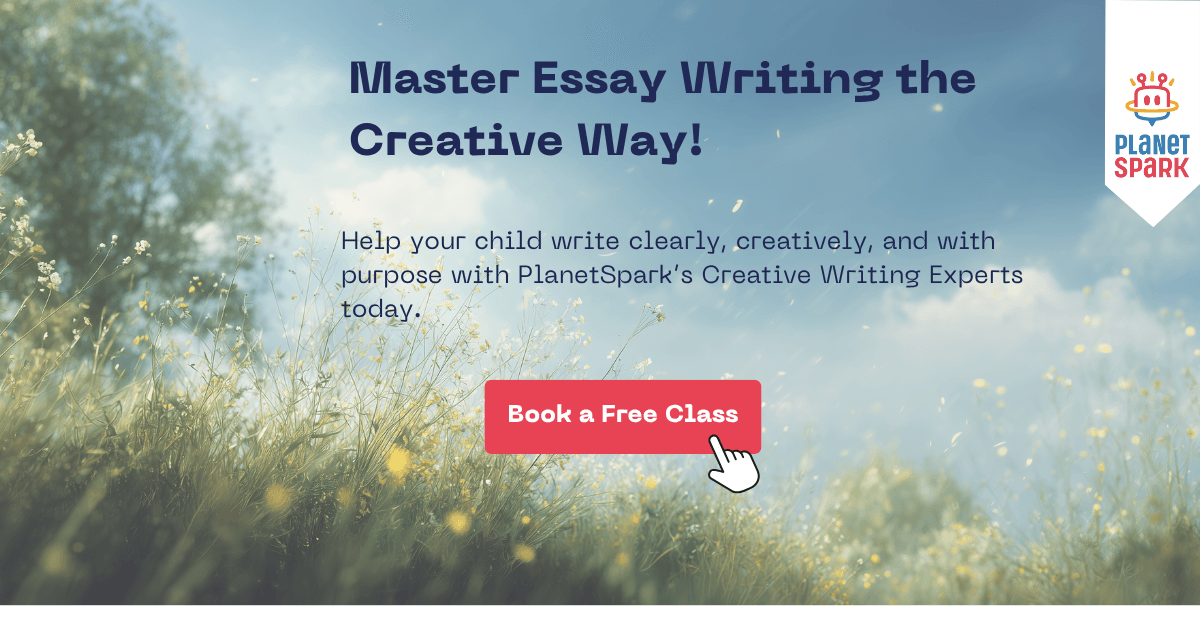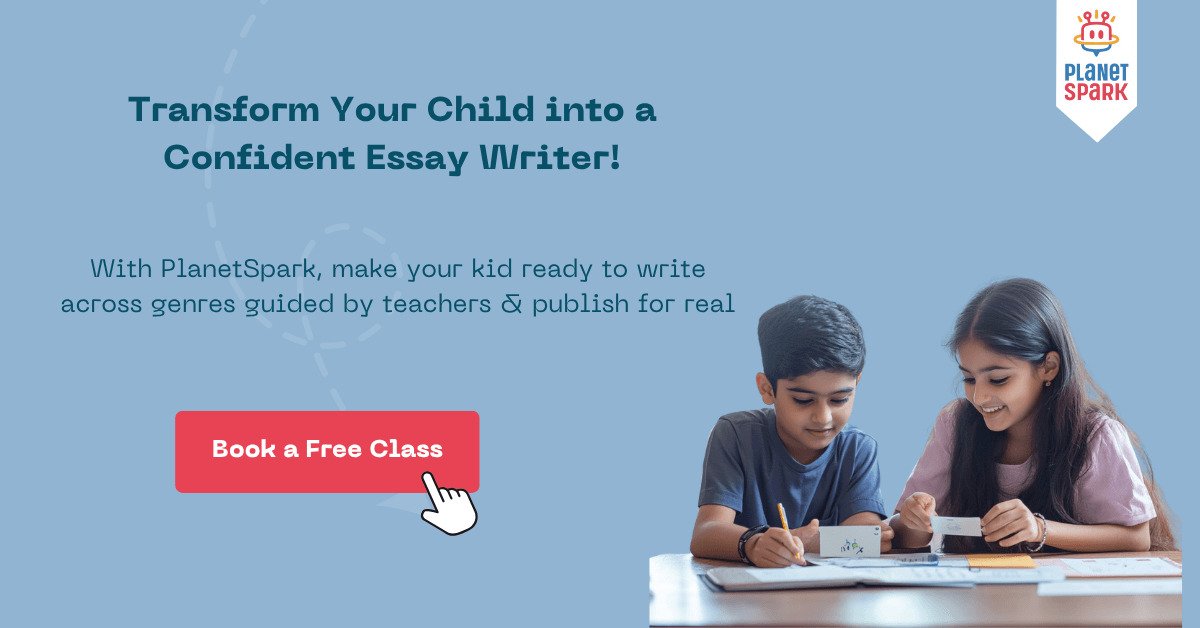Pollution Essay in English: Types & Causes

Pollution is one of the most pressing environmental issues confronting our planet today. It affects every aspect of life from the air we breathe to the water we drink and the soil that nourishes our crops. In this pollution essay, we will explore the different types of pollution, their causes and consequences, and the urgent need for action.
Let’s find out how platforms like PlanetSpark’s Creative Writing Program empower children to express such environmental concerns through structured and impactful writing.

Short Essay On Pollution In English
Get some detailed samples for Short Essay on Pollution in English for four types of pollutions:
Air Pollution Essay
Air pollution refers to the presence of harmful substances in the air that we breathe. These pollutants can be in the form of gases, dust, smoke, or biological particles that contaminate the atmosphere and pose serious risks to human health and the environment. It is one of the most pressing environmental issues in today’s world and affects every living being on the planet.
The major sources of air pollution include the emissions from vehicles, industrial waste released into the air, and the burning of fossil fuels such as coal, oil, and natural gas. These activities release pollutants like carbon monoxide, sulfur dioxide, nitrogen oxides, and fine particulate matter into the air. Natural events such as wildfires, volcanic eruptions, and dust storms can also contribute to air pollution, though human activities remain the primary cause.
Effects of Air Pollution:
One of the most direct impacts of air pollution is on human health. Breathing polluted air can lead to respiratory illnesses like asthma, bronchitis, chronic cough, and in extreme cases, lung cancer. Children, the elderly, and people with pre-existing health conditions are especially vulnerable.
Air pollution also causes acid rain, which occurs when pollutants like sulfur dioxide mix with rainwater in the atmosphere. Acid rain can damage crops, harm aquatic life, and erode buildings and monuments.
Another major concern is the depletion of the ozone layer, which protects life on Earth from harmful ultraviolet (UV) rays. Certain air pollutants, such as chlorofluorocarbons (CFCs), damage this protective layer, increasing the risk of skin cancer, eye problems, and other health issues caused by excessive UV exposure.
What Can Be Done?
To reduce air pollution, we must take conscious steps like using public transport, switching to clean energy, planting trees, and reducing the use of fossil fuels. Industries must be regulated to ensure safe emission practices.
By becoming more aware and adopting eco-friendly habits, we can breathe cleaner air and ensure a healthier planet for future generations.
Not just essay writing, let's practice the speech on Air Pollution.
Water Pollution Essay
Water is one of the most vital resources on Earth. It supports all forms of life and is essential for drinking, farming, cleaning, and industry. However, water pollution the contamination of lakes, rivers, oceans, and groundwater has become a growing concern due to increasing human activities.
Water becomes polluted when harmful substances like chemicals, waste, or microorganisms are introduced into it. This pollution can make water undrinkable, harm marine life, and spread dangerous diseases.
Causes of Water Pollution
A major source of water pollution is industrial waste. Factories often dump untreated chemicals and toxins directly into rivers and lakes. Oil spills from ships and rigs form thick layers over oceans, suffocating marine animals and damaging coastal ecosystems.
Another cause is the discharge of untreated sewage and household waste into water bodies. This leads to the growth of harmful bacteria and viruses. Agricultural runoff, containing pesticides and fertilizers, also contributes significantly. These chemicals flow into water bodies during rain and damage aquatic ecosystems.
Effects of Water Pollution
Water pollution causes the death of aquatic organisms and leads to the destruction of ecosystems. Fish and other creatures cannot survive in oxygen-deprived or chemically toxic water. Polluted water also spreads diseases like cholera, typhoid, and dysentery, especially in areas lacking clean drinking water.
Conclusion
To protect our water sources, we must act now by treating waste properly, reducing plastic use, choosing eco-friendly farming, and educating others. With small efforts and powerful writing, even young learners can make a big impact.
Soil Pollution Essay
Soil is one of the most important natural resources on Earth. It supports plant life, provides food for humans and animals, and plays a crucial role in maintaining ecological balance. However, when harmful substances enter the soil, it leads to soil pollution, a serious environmental issue that affects agriculture, ecosystems, and human health.
Soil pollution occurs when toxic chemicals, salts, radioactive materials, or disease-causing agents are introduced into the soil. These pollutants degrade the quality of the soil, making it unfit for plant growth and reducing its natural ability to support life.
Common Sources of Soil Pollution
There are several major sources responsible for polluting the soil:
Improper disposal of industrial and household waste leads to the accumulation of harmful chemicals, plastics, and metals in the soil. These toxins can remain in the ground for years, harming organisms that live there.
Excessive use of pesticides, herbicides, and fertilizers in agriculture also contributes to soil contamination. While these chemicals are intended to protect crops, they often destroy helpful microorganisms and degrade the soil’s natural fertility.
Mining activities and oil spills disturb the natural structure of the soil and introduce heavy metals and petroleum-based pollutants, which are extremely difficult to remove.
Consequences of Soil Pollution
The impact of soil pollution is far-reaching. One of the most significant effects is the reduction in soil fertility, which directly affects crop yield and food production. Polluted soil produces toxic crops that may contain harmful substances. When consumed, these can enter the human food chain, posing serious health risks.
Additionally, soil pollution leads to the loss of biodiversity underground. Earthworms, insects, fungi, and bacteria all of which are essential for a healthy ecosystem—either die off or migrate to cleaner areas, disrupting the balance of nature.
Conclusion
Soil pollution may start underground, but its effects reach far above the surface. To safeguard our health and environment, we must reduce chemical use, properly manage waste, and raise awareness—because healthy soil means a healthy future.
Noise Pollution Essay
Noise pollution is a less visible but highly harmful form of environmental pollution. Unlike air or water pollution, noise pollution does not contaminate any physical substance but it deeply disrupts mental peace, physical well-being, and overall quality of life. It refers to unwanted or excessive sound that disturbs normal activities such as sleeping, working, or relaxing.
Noise pollution is caused by several everyday sources. Loudspeakers used during celebrations or events, constant traffic noise, construction work, railway stations, airports, and industrial machinery all contribute to high noise levels, especially in urban areas. With increasing urbanization and population, the level of noise in our environment is continuously rising, affecting not only humans but also animals.
Health Impacts of Noise Pollution
The effects of noise pollution go far beyond mere irritation. Prolonged exposure to loud sounds can lead to stress and anxiety, especially in children and elderly people. It interferes with our ability to relax and concentrate, reducing mental clarity and emotional stability.
One of the most serious consequences is sleep disturbance. People living near highways, railway tracks, or industrial zones often suffer from poor sleep quality, which affects their energy levels, mood, and health.
Hearing loss is another critical concern. Continuous exposure to loud sounds, especially without protection, can damage hearing permanently. This is common among workers in factories, airports, or musicians without proper ear safety.
Noise pollution also reduces productivity. In workplaces or schools where background noise is constant, focus and performance decline. Even wildlife is affected—animals lose their ability to communicate, hunt, or migrate due to noisy environments.
Conclusion
Noise pollution may not leave visible marks, but its effects are deep and lasting. By using quieter technologies, reducing unnecessary noise, and spreading awareness through writing, we can create a calmer, healthier world for all.
Master Essay Writing the Creative Way!
From persuasive essays to environmental topics, help your child write with clarity, structure, and imagination.
Book a FREE Trial Class with PlanetSpark’s Creative Writing Experts today!
Pollution Essay in English 150 Words
Pollution refers to the presence or introduction of harmful substances into our environment, making it unhealthy for living beings. It affects the air we breathe, the water we drink, the soil we grow crops in, and even the sounds we hear every day. The major sources of pollution are vehicles, plastic waste, harmful chemicals, and noise from machines and traffic.
Air pollution can cause serious health issues like asthma and lung diseases. Water pollution kills aquatic animals and make it unsafe for drinking. Soil pollution reduces the quality of land and affects the growth of plants. Noise pollution leads to stress, hearing problems, and lack of concentration.
To fight pollution, we must act responsibly. We can recycle waste, avoid plastic, plant trees, use bicycles or public transport, and conserve electricity and water. Educating others about pollution is also important.
Pollution is a global issue that needs everyone’s attention. If we all work together and take eco-friendly actions, we can create a cleaner, healthier, and safer planet for ourselves and future generations.
PlanetSpark encourages learners to understand the cores of creative essay writing to strengthen argumentative and persuasive writing skills.
Essay On Pollution In 250 Words
Pollution is one of the most serious environmental challenges we face today. It refers to the contamination of natural elements like air, water, and soil, and even includes excessive noise and light that disturb the balance of life. Pollution is primarily caused by human activities such as burning fossil fuels, cutting down forests, improper disposal of industrial and household waste, and the use of non-biodegradable materials like plastic.
Air pollution is caused by the release of harmful gases from vehicles, factories, and burning of garbage. It leads to breathing problems, asthma, and increases the risk of lung cancer. It also plays a major role in global warming and climate change. Water pollution occurs when industrial waste, plastic, and sewage are dumped into rivers and oceans. It harms marine life and makes water unsafe for human use. Soil pollution reduces the fertility of land due to chemicals and waste, affecting food production. Noise pollution from honking vehicles, construction work, and loudspeakers causes stress, hearing issues, and disturbs both humans and animals.
To fight pollution, we must act responsibly. Using public transport, recycling, conserving electricity, switching to renewable energy, and avoiding plastic are good starting points. Governments should also enforce strict environmental laws.
Children can play a major role in protecting the environment. They can plant trees, say no to plastic, conserve water and energy, and spread awareness through essays, drawings, and storytelling.
If each one of us takes small steps, we can together build a cleaner and greener future.
How PlanetSpark Creative Writing Classes Help Kids Master Essay Writing
Hone your essay writing skills with PlanetSpark’s Creative Writing Program is thoughtfully designed to transform young learners into confident and skilled writers. Whether it's a structured pollution essay or a persuasive letter on social issues, the platform equips children with both the technical tools and the creative mindset needed for impactful writing.
Key Ways PlanetSpark Supports Essay Writing
Genre-Based Curriculum: Students explore various forms of writing including essays, short stories, journal entries, poetry, and book reviews. Dedicated lesson plans for each genre ensure they understand the nuances of tone, structure, and audience.
Framework-Driven Essay Instruction: Children are taught to write structured essays using internationally recognized methods like:
PEEL (Point, Evidence, Explanation, Link): for argument clarity.
5W1H (Who, What, When, Where, Why, How): for comprehensive coverage.
S.T.O.R.Y: A structure to maintain logical flow and narrative quality.
Integrated Writing + Speaking Approach
After writing their essays, kids present them aloud. This helps reinforce clarity, sentence coherence, and expression strengthening both written and spoken communication.Editing, Feedback & Rewriting Sessions: Children receive real-time feedback from expert teachers, revise their drafts, and develop stronger versions just like professional writers. Peer reviews are also incorporated to build collaborative critique skills.
Creative Thinking Tools: PlanetSpark uses story dice, prompts, image-based writing exercises, and imagination boosters to help kids think outside the box even while writing factual essays like those on pollution or social issues.

More useful links:
Personalized Communication Report
Record a video to get a AI generated personalized communication report for your child

Hi There, want to try these
tips for your child with
LIVE with our expert coach?
Let's check your child's
English fluency
